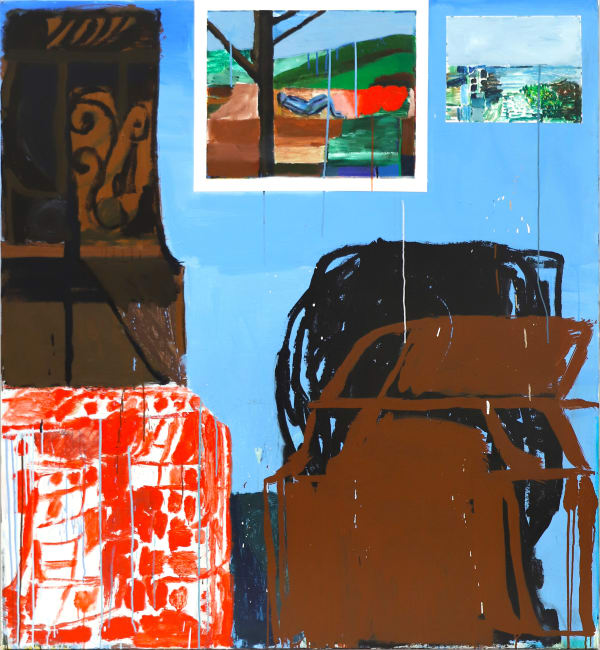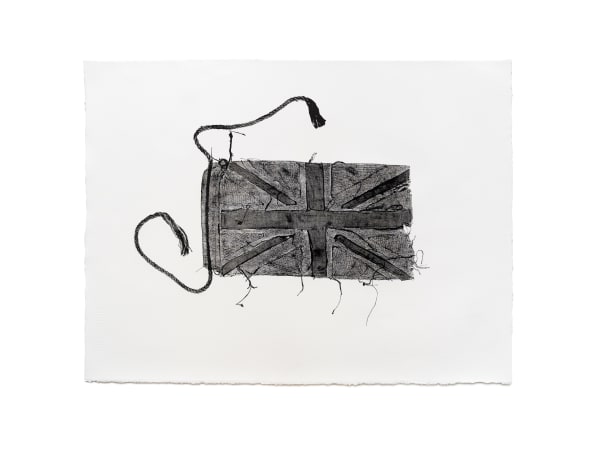
Holly Anderson's painting practice investigates sensory experiences between light and landscape. Hovering between the figurative and the abstract, raw brush strokes fragment into larger monochromatic compositions, building surfaces whose surprising flatness and geometry heightens the strangeness of their persistent realism.
Sunlight permeates an array of Holly's subject matter, with bright bursts of white negative space disrupting the order of gridded geometric surfaces. These painterly grids of stripes and squares produce complex systems that bend or scatter where bright light flashes. Familiar subjects now appear in new light, composed behind the glare of a white hot sun and developing a new visual language for the brilliance of sunlight in the Australian landscape.









Sally Anderson’s work draws heavily on personal domestic, maternal, and relational experiences, as well as second-hand encounters with landscapes, to explore how meaning and memory are held, stored, and carried. She is particularly interested in the concept of ‘the souvenir’ and the ways we authenticate experiences and navigate notions of reality and truth.
Anderson recontextualizes and arranges personal and intimate experiences with art historical references to address how motherhood, domesticity, and creative practice are, for her, reciprocal and ultimately entangled. Her paintings deliberately oscillate between abstraction and representation, using still-life and landscape motifs as symbols of containment and care. Stella Rosa McDonald writes that Sally’s paintings are 'like wombs or libraries—where gestation and digestion are tacitly implied.'
Born in Lismore, Sally Anderson began her undergraduate studies in Visual Art at Southern Cross University before transferring to the College of Fine Art in Sydney. A past finalist in the Sulman Prize at the Art Gallery of New South Wales, the Portia Geach Memorial Award, the Sunshine Coast Art Prize and the Paddington Art Prize, Anderson was invited to participate in the Association of Icelandic Visual Artists residency in Reykjavik, Iceland, in 2014. In 2017 Sally Anderson won the prestigious Brett Whiteley Travelling Art Scholarship administered by the Art Gallery of NSW and completed a residency at the Cité Internationale des Arts in Paris.





'Most of the work I do starts with drawing,' says the artist about his wide-ranging practice. The drawings are then fragmented and redrawn, and the new compositions incorporated into cyanotypes, hand-etched de-silvered mirrors, mobiles and installations. 'There's a balance between concept and formalism, and where those two meet,' explains Tom.
Tom has exhibited in Australia, Japan and Italy, and has undertaken residencies with Perth Institute of Contemporary Arts (PICA), Museo de Arte Moderno Chiloé (MAM), Fremantle Arts Centre (FAC), North Metro TAFE, Sapporo Tenjinyama Art Studio, and Parramatta Artists’ Studios. He was a 2013 recipient of a Clitheroe Foundation Mentorship.

Tom Blake
index, chair (leaf in the stream), 2024
cyanotype, artist-made brass frame
41 x 31.5 x 2 cm (framed)



A true multidisciplinary artist, Jordan Gogos’ creative practice spans textiles, design, and runway shows that infuse his queer and Greek-Australian lived experience with a sustainable approach to textiles that reflects a profound exploration of materiality, where form evolves spontaneously, and the final outcome is dictated by chance.
An artist who defies convention, Jordan’s practice thrives on spontaneity and the fortuitous interplay of materials that revolve around repurposed, recycled, and dead stock textiles sourced from friends and colleagues, employing couturier techniques such as layering, compressing, felting, and embroidering.
Jordan’s work is held in the collections of the National Gallery of Australia, Art Gallery of South Australia, and Powerhouse Museum; is a Creative Resident at Powerhouse Museum; and is a recipient of the Creative Force Award at GQ’s Men of the Year Awards.



Since 2001, Fiona Lowry’s practice has explored the complexity of the human condition. Through the use of airbrushed pastels and monochromatic colour palettes, Lowry’s images maintain an overarching softness and ambiguity. This aesthetic serves to complement and enhance the deeply emotive undertones such as vulnerability, melancholia and danger that remain pervasive within her work.
Lowry’s paintings of the Australian landscape portray the bush as strangely beautiful, alluring and steadfast. Rendered in vibrant, dreamlike colours and made nebulous by the artist’s distinctive airbrush technique, nature is majestically stark yet also complex, imbued with a sense of foreboding and menace. Her paintings present the natural environment as a dreamlike, surreal theatre to events associated with interventions of the human kind – deeds or misdeeds that infiltrate and permeate the scene with a profound unease that extends its grip to paranoia and the psychotic.
Winner of the Archibald Prize, Moran Portrait Prize, and Fleurieu Landscape Prize, Lowry's work is also held in several public, university, and corporate Australian collections, including the National Gallery of Australia, Canberra; Art Gallery of New South Wales, Sydney; Artbank, Sydney; Macquarie Bank, Sydney; National Portrait Gallery, Canberra; UBS, Sydney; and The University of Queensland Art Museum, Brisbane.




Kyra Mancktelow’s multidisciplinary practice investigates legacies of colonialism, posing important questions such as how we remember and acknowledge Indigenous histories. A Quandamooka artist with links to the Mardigan people of Cunnamulla, Kyra’s practice includes printmaking, ceramics, and sculpture – each applying a unique and distinct aesthetic. Kyra works with various materials to share her rich heritage, stories, and traditions to educate audiences and strengthen her connection to Country. Her printmaking explores intergenerational trauma as a result of forced integration on colonial missions, and her use of local materials in her sculpture, including clay, emu features, and Talwalpin (cotton tree), strengthens her connection to Country.
Currently undertaking a PhD at Queensland College of Art, Kyra regularly exhibits in both solo and group exhibitions nation wide. Kyra won the 2021 Telstra Emerging Artist Award at The National Aboriginal & Torres Strait Islander Art Awards, and a Special Commendation at the 2021 Churchie National Emerging Art Prize.



Thea Anamara Perkins is an Arrernte and Kalkadoon artist whose practice incorporates portraiture and landscape to question representations of First Nations peoples and Country. With a delicate hand, Thea answers heavy questions about what it means to be First Nations in contemporary Australia, and interrogates portrayal.
Thea’s middle name Anamara is an Arrernte word that describes a river and a Dreaming that runs north of Mparntwe (Alice Springs) – the place that keeps calling her back and has been the wellspring of art and activism for her family, and by extension, the nation. Perkins continues her family’s commitment to what she calls “strong and ready communication” and is part of an extraordinary dynasty of First Nations activists and creatives that includes activist Charles Perkins (her grandfather), Arrernte elder Hetti Perkins (her great-grandmother), curator Hetti Perkins (her mother) and acclaimed film director Rachel Perkins (her aunt).
Perkins routinely delves into her family’s photographic archive for source material, attracted by the hyper-saturated, almost cinematic, glow of old photos, and the melancholia that comes with seeing a moment in time you can no longer access. She is most drawn to snapshots that evoke feelings of comfort and certainty – smiling faces, happy memories. The glimmer, she calls it. Her compositions hone in on this by removing the background noise, reducing the photo to its very essence – a gesture, a colour, or an evocation of place.
Raised and based in Sydney, Thea has family ties to the Redfern community and has worked in a broad range of community projects. Thea was the recipient of the 2023 La Prairie Art Award, administered by The Art Gallery of NSW, and won the Brett Whiteley Travelling Art Scholarship in 2021, and the Alice Prize & Dreaming Award in 2020.



Since the late 1980s, Joan has exhibited across a range of mediums, from drawing, painting, photography and sculpture to installation, video, and virtual reality. Her experimental works combine colonial iconography and landscape painting with collaged elements of western commodity culture connected to land tenure and Aboriginal peoples' active presence on the land.
Joan's use of fluorescent yellow and high-visibility clothing symbolises colonisation and fear. The act of depicting people in this bright clothing and placing fluorescent objects in the landscape does more, however, than simply illustrate colonisation; it also highlights and exaggerates the foreign or alien aspects of her work and its association with the landscape and the cultural and spiritual connection to place.
Recent projects include designing the hoarding for The Art Gallery of New South Wales' Sydney Modern expansion, and illuminating the façade of The National Gallery of Australia during the 2021 Enlighten Festival. Joan was awarded the National Art School Fellowship in 2023.







A regular finalist in major art prizes, Sally won the People's Choice Award at the 2021 Telstra National Aboriginal and Torres Strait Islander Art Awards (NATSIAA) at the Museum and Art Gallery of the Northern Territory, and the Roberts Family Aboriginal and Torres Strait Islander Prize at the Art Gallery of New South Wales in 2022. The British Broadcasting Corporation (BBC) named Sally as one of the 100 women of the year in 2022, and is a member of the National Gallery of Australia Council and Chair of its First Nations Advisory Group.






Vipoo has exhibited extensively around the world, including Museum of Fine Arts, Boston; Saatchi Gallery, London; Ayala Museum, Philippines; Yingge Ceramics Museum, Taiwan; Nanjing Arts Institute, China and the National Gallery of Thailand. His work is held in national and international public collections across the globe including Henan Museum, China; Roopanakar Museum of Fine Arts, India; Craft Council, UK, and the National Gallery of Australia. In 2021, Vipoo was awarded the Ceramic Artist of the Year by the American Ceramic Society for his contribution to the global clay community.







Zhang's work is inspired by horror cinema, Chinese mythology and botany, adopting and placing symbols and motifs in compositions of harmonic dissonance. Her practice explores Chinese mythology – paintings, sculptures and scroll-like banners that incorporate demons, dismembered body parts and organs drawn from anatomy books – overlaid with illustrations of flowers, bones, scholar rocks and auspicious imagery presented in a sugary palette. The aim is to create a visual cacophony, a disjointed and disorientating mash-up of symbols and imagery in an attempt to in part reconcile and make sense of the fissures and contradictions that define her own identity.


* denotes required fields
We will process the personal data you have supplied in accordance with our privacy policy (available on request). You can unsubscribe or change your preferences at any time by clicking the link in our emails.
We won't send you lots of emails. Promise.
* denotes required fields
We will process the personal data you have supplied in accordance with our privacy policy (available on request). You can unsubscribe or change your preferences at any time by clicking the link in our emails.